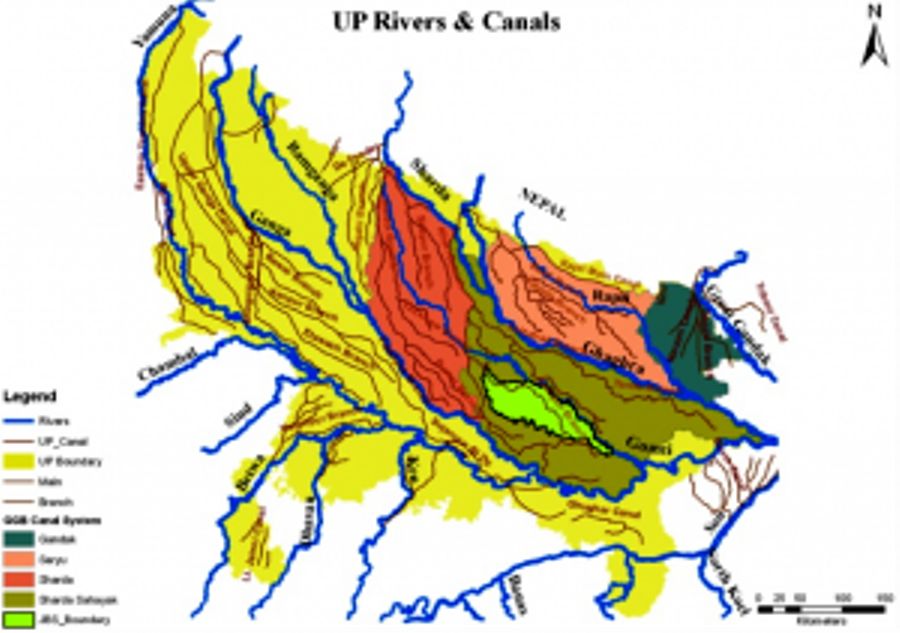
Figure 1. Major tributaries of the Ganga River in Uttar Pradesh. The River Gomti drains the area between the Sharda and Ramganga Rivers.
Source: Venkatesh Dutta
Community and government efforts are underway to revive the Gomti River – an important tributary of the Ganga in India’s state of Uttar Pradesh (UP). The Gomti River is a major source of drinking water for more than 3.5 million people, but declining river flows and increased discharge of pollutants in recent years have led to a decline in water quality.
Geography of the Gomti River and the surrounding areas
The Ganga, Yamuna, Ramganga, and Gomti are rivers of West Ganga Plains of India. They are characterized by deep, stable and incised channels, and low discharge per unit area as well as low sediment yield. The Gomti River is unique in that it is both rain and groundwater-fed; the other major tributaries of the Ganga in this region are snow-fed rivers originating in the Himalayas. The Gomti River joins the river Ganga at Kaithi Ghat near Varanasi (see Figure 1).
Why is the gomti River under stress?
Flow volumes in the Gomti and its tributaries have decreased in recent years, and in the same period pollution loads have increased due to urbanization and wastewater discharge. Groundwater levels have also decreased as monsoon rainfall declines and deforestation sweeps the region. Many of the Gomti’s tributaries that used to be perennial have become seasonal rivers, dry during the non-monsoon seasons. The reduction in flow in its tributaries has led to reduced water flow in the Gomti itself.1 Climate change and neo-tectonics may have also contributed to the changing regime of the river and reduced discharge (see Figure 2).2

Figure 2. Gomti River Basin with major gauging stations – Neemsar, Sultanpur, Jaunpur and Maighat. Source: Venkatesh Dutta
Further, there are more than 45 points discharging untreated wastewater into the Gomti; pollution levels are highest along the 22-km stretch in the UP state capital, Lucknow, owing to millions of litres of untreated domestic waste released daily from the city. Its tributaries are also filled with domestic sewage and sludge from encroaching urban development taking place in the riverbed on privately-owned land.
Restoration Activities
Recognizing the importance of the Gomti River, the Chief Secretary of UP directed the state irrigation department to prepare a riverfront development plan for the Gomti’s Lucknow stretch. In March 2011, the Gomti Study Group organized a community-led research expedition on the Gomti River.3 Following the expedition in the summer of 2011, the UP government took important decisions targeted at the immediate restoration of the river in a high-level meeting under the Chief Secretary. Key decisions included:
- Preparation of a district-wide plan for the river.
- Increased monitoring of pollution discharges from sugar factories and distilleries upstream of Lucknow.
- Release of water into the Gomti and its tributaries.
- De-silting of the river channel and construction of check dams.
- Restoration of wetlands near the river using funds provided under the Mahatma Gandhi National Rural Employment Guarantee Act; work began in 2011 but has been start-and-stop due to differing priorities of elected officials since that time (see Figure 3).

Figure 3. Marshy land between Shajahanpur and Kheri districts along the Gomti River. Source: Venkatesh Dutta
The focus of the current government is a landscape-based development project, which will ultimately reclaim the river banks for uses such as shops, entertainment areas, walking-trails etc., and its planning does not focus on the restoration of the river itself. The development in these plans would further encroach on the river and is the opposite of what is needed – which is an increase in the river’s discharge capacity to accommodate floods. Moreover, the current project ignores other critical restoration measures such as removing the encroachment on the active flood-way, conserving the river’s floodplains, reviving the tributaries and rejuvenating the stressed aquifers in its catchments.
Since September 2014, a committee set up by India’s Union Ministry of Water Resources is deliberating over the release of excess water into the Gomti River downstream of Lucknow from the Ghaghra River through a pipeline. The two rivers might be linked at Ramnagar, Barabanki where the distance between the two rivers is about 60 kms.4 Prior proposals for linking rivers in this region via canal / tunnel were rejected on technical grounds.
Solutions
In light of the issues facing the Gomti River, there are ten regulatory interventions that could be adopted to contribute towards a cleaner River Gomti:
- Promote and fund mapping and demarcation of the entire Gomti floodplain, from the source to the confluence with the Ganga.
- Declare 250 m from the river midstream on both sides as a no construction zone to be used only for plantations, remove the illegal encroachments in the flood plain and, where development is permitted, enforce proper regulatory codes related to building and construction.
- Declare the source as well as the confluence of all 24 tributaries as “eco-fragile areas” which have protected status.
- Improve the drainage in the upper catchments and the storage of rainwater; construct check dams in the upper segments of tributaries where post-monsoon groundwater table is below 8 meters. Ponds, which existed along the course of the river, could also be revived again for storing the excess water during the monsoon. In the dry summer months, this water could be redirected into the tributaries of the Gomti River.
- Implement significant re-forestation incentives for the next ten years along the river banks. There are ample lands available by the side of the river which can be utilized for forestation. This could lead to the creation of river gardens along the banks which will help in developing micro-ecosystems for birds, insects and other flora and fauna. The parklands will also help local people to connect with the river and be motivated to protect it. In order to facilitate this aim there is a need to identify business groups, educational institutions, banks, NGOs that could each “adopt” a 500 meter stretch of the river. and to give these stakeholders advice on how to developing forests/gardens.
- Remove the silt deposited in the riverbed along the major settlements in Lucknow, Jaunpur and Sultanpur, which was brought from the sewers.
- Avoid the installation of large surface water treatment plants and use decentralized treatment and use wastewater for non-potable purposes before discharging to the treatment works. Standard low cost treatment in the drains could also be used by creating baffled chambers and several models of decentralized wastewater treatment systems could be customized locally.
- Strictly monitor all of the sugar factories and distilleries located around the river in Sitapur and upstream, as they are known to discharge major pollution loads in the river.
- Prohibit all dumping of solid waste in the river and ensure that sanitary landfills in the river basin comply with regulatory standards.
- Declare the Gomti a “State River” of UP; since the river originates in UP and its confluence with the Ganga is in the UP, there is no inter-state conflict with regard to declaring it a State River.
What are we looking for?
Based on empirical evidences and experiences in recent past we are looking at a water catastrophe in India. The country faces drought or deluge, millions moving out of agriculture and then into urban systems without any transition or training. This will not only give to loss of life and land but can be a reason of major unrest in India.
At this point of time we are aiming to build a strong representation to protect water and natural systems at the local level. We want policy interventions and strong implementation at states level to keep natural resources untouched and free to take their own form for generations to come.
If you are someone who knows about local water systems in your community and want to actually work on making them better, send the details on coordinators@ballotboxindia.com
If you know someone who can make a difference, make an introduction with this effort, you can also write to coordinators@ballotboxindia.com, or fill "Contact a coordinator" form by clicking the buttons on this page.
If you have a few hours to work in your community for common good, let us know and join as a coordinator.
Would my efforts be funded? Yes if you have some time, skill and aptitude to make a difference, ballotboxindia is the right platform. Get in touch with coordinators@ballotboxindia.com with your details.
Thanks
Coordinators @ballotboxindia.com






 tag on profile.
tag on profile.
By Venkatesh Dutta {{descmodel.currdesc.readstats }}
Venkatesh Dutta {{descmodel.currdesc.readstats }}
Figure 1. Major tributaries of the Ganga River in Uttar Pradesh. The River Gomti drains the area between the Sharda and Ramganga Rivers.
Source: Venkatesh Dutta
Community and government efforts are underway to revive the Gomti River – an important tributary of the Ganga in India’s state of Uttar Pradesh (UP). The Gomti River is a major source of drinking water for more than 3.5 million people, but declining river flows and increased discharge of pollutants in recent years have led to a decline in water quality.
Geography of the Gomti River and the surrounding areas
The Ganga, Yamuna, Ramganga, and Gomti are rivers of West Ganga Plains of India. They are characterized by deep, stable and incised channels, and low discharge per unit area as well as low sediment yield. The Gomti River is unique in that it is both rain and groundwater-fed; the other major tributaries of the Ganga in this region are snow-fed rivers originating in the Himalayas. The Gomti River joins the river Ganga at Kaithi Ghat near Varanasi (see Figure 1).
Why is the gomti River under stress?
Flow volumes in the Gomti and its tributaries have decreased in recent years, and in the same period pollution loads have increased due to urbanization and wastewater discharge. Groundwater levels have also decreased as monsoon rainfall declines and deforestation sweeps the region. Many of the Gomti’s tributaries that used to be perennial have become seasonal rivers, dry during the non-monsoon seasons. The reduction in flow in its tributaries has led to reduced water flow in the Gomti itself.1 Climate change and neo-tectonics may have also contributed to the changing regime of the river and reduced discharge (see Figure 2).2
Figure 2. Gomti River Basin with major gauging stations – Neemsar, Sultanpur, Jaunpur and Maighat. Source: Venkatesh Dutta
Further, there are more than 45 points discharging untreated wastewater into the Gomti; pollution levels are highest along the 22-km stretch in the UP state capital, Lucknow, owing to millions of litres of untreated domestic waste released daily from the city. Its tributaries are also filled with domestic sewage and sludge from encroaching urban development taking place in the riverbed on privately-owned land.
Restoration Activities
Recognizing the importance of the Gomti River, the Chief Secretary of UP directed the state irrigation department to prepare a riverfront development plan for the Gomti’s Lucknow stretch. In March 2011, the Gomti Study Group organized a community-led research expedition on the Gomti River.3 Following the expedition in the summer of 2011, the UP government took important decisions targeted at the immediate restoration of the river in a high-level meeting under the Chief Secretary. Key decisions included:
Figure 3. Marshy land between Shajahanpur and Kheri districts along the Gomti River. Source: Venkatesh Dutta
The focus of the current government is a landscape-based development project, which will ultimately reclaim the river banks for uses such as shops, entertainment areas, walking-trails etc., and its planning does not focus on the restoration of the river itself. The development in these plans would further encroach on the river and is the opposite of what is needed – which is an increase in the river’s discharge capacity to accommodate floods. Moreover, the current project ignores other critical restoration measures such as removing the encroachment on the active flood-way, conserving the river’s floodplains, reviving the tributaries and rejuvenating the stressed aquifers in its catchments.
Since September 2014, a committee set up by India’s Union Ministry of Water Resources is deliberating over the release of excess water into the Gomti River downstream of Lucknow from the Ghaghra River through a pipeline. The two rivers might be linked at Ramnagar, Barabanki where the distance between the two rivers is about 60 kms.4 Prior proposals for linking rivers in this region via canal / tunnel were rejected on technical grounds.
Solutions
In light of the issues facing the Gomti River, there are ten regulatory interventions that could be adopted to contribute towards a cleaner River Gomti:
Attached Images